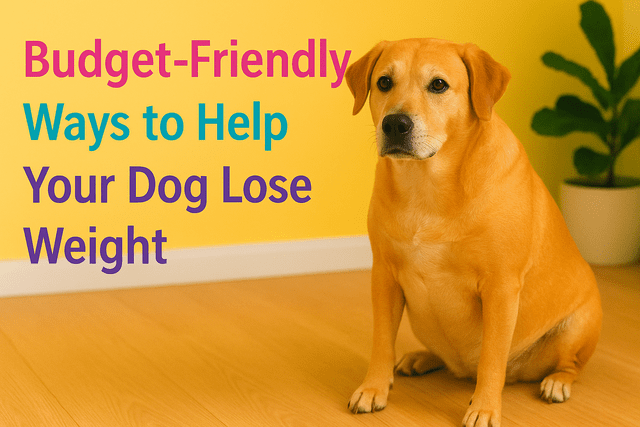
Budget-Friendly Ways to Help Your Dog Lose Weight (Without Expensive Food or Gadgets)
Obesity in dogs is becoming more common, but the good news is, it’s never too late to help your dog shed those extra pounds—without breaking the bank. Weight loss isn’t just about aesthetics; it can lead to better mobility, increased energy, and a longer, healthier life for your pet. And the best part? You don’t need fancy food or costly gadgets. Let’s dive into some simple, budget-friendly ways to get your dog back to a healthy weight.
Table of Content
- 1 Quick Take
- 2 Spot-Check: Is Your Dog Overweight?
- 3 Set a Calorie Target (Using Food You Already Own)
- 4 Portion Control on a Shoestring
- 5 Treats: Cheap, Safe, and Low-Calorie
- 6 Exercise That Costs ₹0
- 7 DIY Enrichment to Slow Eating & Boost Activity
- 8 Food Choices: When (and When Not) to Switch
- 9 Track, Review, Adjust
- 10 When to Call the Vet
- 11 Final Thoughts
Quick Take
- Why it matters: Carrying extra weight puts stress on your dog’s joints, heart, and organs. Weight loss can improve their quality of life and reduce long-term veterinary costs.
- Promise: You can implement these changes today without a massive budget, using what you already have at home.
- Important: Target 1-2% weight loss per week—slow and steady is safest!
Spot-Check: Is Your Dog Overweight?
Before diving into a weight-loss plan, it’s important to assess where your dog currently stands.
Body Condition Score (BCS)
Check if your dog is overweight using a Body Condition Score (BCS) chart, which is a simple 9-point scale that helps determine if your dog’s weight is in a healthy range. Look for things like visible ribs, a waistline (when viewed from above), and an abdominal tuck (when viewed from the side).
If you’re unsure, your vet can help assess your dog’s weight and recommend the best approach.
Weigh-In
To track progress, start by weighing your dog. You can do this at home by stepping on the bathroom scale while holding your dog, then subtracting your weight from the total. Aim for weekly weigh-ins to monitor their progress.
Set a Calorie Target (Using Food You Already Own)
One of the most effective (and budget-friendly) ways to help your dog lose weight is by controlling their calorie intake. You don’t need to buy expensive food or supplements—just the right portions.
How to Calculate Calories
Use a simple formula to estimate your dog’s calorie needs. Begin with their Resting Energy Requirement (RER), which is calculated as:
RER = 70 × (ideal weight in kg)^0.75
From there, calculate your dog’s Maintenance Energy Requirement (MER) by multiplying their RER by an activity factor (usually around 1.2 to 1.5). For weight loss, start by feeding around 80% of their ideal weight MER.
If that sounds complex, don’t worry! You can also start by using 63 kcal × ideal weight in kg^0.75 as an estimate.
Remember: Calorie needs vary per dog. It’s important to track their progress and adjust portions if needed.
Portion Control on a Shoestring
Now that you know your dog’s calorie target, it’s time to focus on portion control—a surprisingly easy, budget-friendly solution.
Weighing Food
Using a kitchen gram scale is one of the best ways to measure food accurately, ensuring you’re not overfeeding. A kitchen scale typically costs only ₹500-₹800 and will pay for itself in the long run by preventing overfeeding.
Check Labels
Most commercial dog food comes with calorie counts per serving, but make sure to cross-check the amount per cup or per 100g to ensure you’re not underestimating how much you’re feeding.
Treats: Cheap, Safe, and Low-Calorie
Treats are a big part of many dogs’ diets, but they can quickly add up in calories. Luckily, there are cheap and healthy treat alternatives that can satisfy your dog’s cravings without sabotaging their weight-loss goals.
Budget-Friendly Treat Swaps
Try using carrots, green beans, apple slices (without seeds), or small amounts of plain boiled chicken as low-calorie treats. These are not only healthier but are easy to find and inexpensive.
Stay Within the 10% Rule
Treats should make up no more than 10% of your dog’s total daily calories. For example, if your dog needs 500 calories daily, only about 50 should come from treats.
Note: Always check labels when using treats like peanut butter. Some contain xylitol, which is toxic to dogs.
Exercise That Costs ₹0
Exercise is an essential part of weight loss, but it doesn’t require a gym membership or fancy equipment. Simple, daily physical activity can do wonders.
Brisk Walks
Aim for 30–45 minutes of brisk walking every day. If your dog is out of shape, start slow with shorter, more frequent walks. Adjust the length based on your dog’s fitness level and mobility.
At-Home Play
Engage your dog in interactive games like fetch, tug-of-war, or hide-and-seek. These activities not only burn calories but also stimulate your dog mentally, making them feel more satisfied.
Important: If you live in a hot climate, be mindful of heat safety during walks.
DIY Enrichment to Slow Eating & Boost Activity
If your dog eats too quickly, they may feel hungrier sooner. Slowing down their eating will not only help them feel fuller for longer but will also add some extra movement.
Slow-Feed Options
You don’t need to buy a fancy slow-feed bowl. Instead, you can DIY slow-feed solutions using household items like a muffin tin, tennis balls, or simply scattering food around your living space.
Frozen Treats
Freeze some of your dog’s kibble or low-sodium broth in an ice cube tray for them to lick and chew slowly.
Food Choices: When (and When Not) to Switch
You don’t need to switch your dog’s food to a special weight-loss formula unless recommended by your vet. Many dogs can successfully lose weight by simply eating smaller portions of their regular food, combined with exercise.
If progress stalls, you may want to consider a weight-management food that’s lower in calories but still packed with nutrients.
Track, Review, Adjust
Consistency is key when it comes to weight loss. Keep track of your dog’s weight every week and review their BCS (Body Condition Score) monthly. Aim for 1-2% loss per week, which is both safe and effective.
If progress seems too slow, slightly reduce portions by 5-10%. If your dog is losing too quickly or showing signs of fatigue, consider increasing their food slightly.
When to Call the Vet
If your dog is not losing weight after a few weeks of consistent effort, or if they show any signs of illness (lethargy, vomiting, diarrhea), it’s time to check in with your vet. A sudden loss of weight or an inability to lose weight can indicate underlying health issues that need professional attention.
Final Thoughts
Helping your dog lose weight doesn’t have to be costly. With just a little patience and creativity, you can help them shed pounds in a healthy and sustainable way. The key is consistency, tracking, and adjusting portions as needed. And remember, always consult your vet if you have concerns about your dog’s health or weight loss progress.
By following these budget-friendly tips, you’re setting your dog up for a healthier, longer life—without the need for expensive gadgets or diets.


